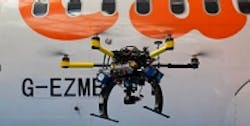UAVs to be used to inspect aircraft for UK’s largest airline
A collaboration between the Bristol Robotics Laboratory and easyJet, the UK’s largest airline, will see the deployment of unmanned aerial vehicles (UAVs) for purposes of aircraft inspection.
The Bristol Robotics Laboratory, a partnership between the University of Bristol and the University of the West of England, will modify existing UAV technologies in order to enable them to inspect easyJet’s fleet of 220 Airbus aircraft. The UAVs will be programmed to scan and assess the planes, reporting back to engineers on any damage which may require further inspection or maintenance work, according to a press release.
The UAVs will not only free up engineers for more advanced tasks, but will also keep costs down, which in turn can keep fares low and help to minimize flight delays, according to Ian Davies, Head of Engineering for EasyJet. In addition, the UAVs will be able to provide information on inaccessible or difficult-to-reach areas of the plane, which will go a long way in safety precautions.
“Aircraft inspection is a great application for drones. Coupled with smart navigation and computer vision, they can get accurate data from really awkward places,” said Dr Arthur Richards, Head of Aerial Robotics at Bristol Robotics Laboratory. “We look forward to working with easyJet to develop safe, effective and efficient drone systems for this challenge.”
In addition to the UAV technology, EasyJet is looking into developing a number of other advanced technologies, including 3D augmented reality glasses, which would enable a remote engineering team to see exactly what a pilot or engineering is seeing through virtual reality glasses.
The Bristol Robotics Laboratory is currently developing these UAVs and will reportedly begin trials in the coming months, with an eye toward introducing them into operation as early as 2015.
View the press release.
Also check out:
Snake robots enable automated assembly of aircraft wings
Google continues robotic push with purchase of UAV company
Venture capital companies to fund robotic navigation technology
Share your vision-related news by contacting James Carroll, Senior Web Editor, Vision Systems Design
To receive news like this in your inbox, click here.
Join our LinkedIn group | Like us on Facebook | Follow us on Twitter | Check us out on Google +
About the Author

James Carroll
Former VSD Editor James Carroll joined the team 2013. Carroll covered machine vision and imaging from numerous angles, including application stories, industry news, market updates, and new products. In addition to writing and editing articles, Carroll managed the Innovators Awards program and webcasts.
